α和α′亚基缺失对大豆分离蛋白乳化特性的影响
孙 贺,于寒松,范宏亮,付洪玲,单单单,吕 博,宋 波,刘珊珊
和亚基缺失对大豆分离蛋白乳化特性的影响
孙 贺1,3,于寒松1,3※,范宏亮1,3,付洪玲1,3,单单单1,3,吕 博4,宋 波2,刘珊珊2
(1. 吉林农业大学食品科学与工程学院,长春 130118;2. 东北农业大学农学院,哈尔滨 150030;3. 国家大豆产业技术体系加工研究室,长春 130118;4. 东北农业大学食品学院,哈尔滨 150030)
为了探究-伴大豆球蛋白(7S)中和亚基缺失对大豆分离蛋白乳化特性的影响,该文以东农47(对照)和3种不同蛋白亚基缺失型(缺失、缺失以及、缺失)大豆为原料提取大豆分离蛋白(Soy Protein Isolate,SPI),通过十二烷基磺酸钠聚丙烯酰胺凝胶电泳(Sodium Dodecyl Sulfate-Polyacrylamide Gel Electrophoresis,SDS-PAGE)技术分析其亚基组成,然后制备乳状液并测定乳化活性指数(Emulsifying Activity Index,EAI)、-电位、粒径、微观结构、稳定动力学指数(Turbiscan Stability Index,TSI)及界面蛋白吸附量。结果表明:亚基缺失型SPI乳状液乳化活性指数最大,为87.59 m2/g;ζ-电位绝对值最大,为47.7 mV;粒径最小,为2.223m;显微结构显示其分子最小且分布最均匀,稳定动力学指数最小;界面蛋白吸附量最大,为31.40%。4种不同SPI乳状液的稳定性结果由大到小为亚基缺失型、东农47、亚基缺失型、和亚基缺失型。研究结果可为高乳化性大豆蛋白系列产品的开发应用提供理论支撑和技术支持。
乳化活性;乳化稳定性;微观结构;大豆分离蛋白;亚基缺失型
0 引 言
近年来,随着人们生活水平的逐步提高以及国家对大健康产业的重视,营养健康的食物越来越得到大家的重视,安全无风险的高乳化性产品的开发具有极其广阔的前景。大豆分离蛋白(Soy Protein Isolate,SPI)具有两亲性结构,由于营养价值高且功能特性多而被广泛应用于工业生产[1-2]。乳状液是由水、油以及乳化剂所形成的一种不稳定体系,由于其具有不同的类型,不仅广泛应用于化妆品和制药,而且也广泛应用于一些食品,如冰淇淋和蛋黄酱。然而,乳层不稳定性可能会降低乳化类产品的货架期[3],但添加具有乳化性能的SPI可以稳定乳状液。
大豆蛋白按沉降系数分为2S,7S,11S和15S 4种组分,-伴大豆球蛋白(7S)和大豆球蛋白(11S)是占种子蛋白总量65%~80%的主要成分[4]。-伴大豆球蛋白(7S)是由非共价结合的亚基,和组成的同源三聚体,大豆球蛋白(11S)是由通过二硫键连接的A和B多肽组成的六聚体蛋白[5]。7S/11S比例对乳化性能的影响已有较多研究。陈海敏等[6]研究了大豆蛋白的7S/11S比例对凝胶与乳化性能的影响,结果表明7S/11S比值越高,乳化活性越高,即7S含量越高,大豆蛋白的乳化性会越好,且7S各亚基对SPI乳化性贡献率远大于11S[7-8]。刘春等[9]以亚基正常品种、A3B4亚基缺失、A1aA1b亚基缺失、A5A4B3亚基缺失、M11SR(11S含量极低)和粗7S蛋白6个大豆品种为原料,对蛋白功能性进行评价,结果表明:11S中单个亚基缺失对乳化性和乳化稳定性的影响不显著,11S含量显著降低或缺失能提高大豆蛋白的乳化性和乳化稳定性。Cheng等[10]通过对大豆蛋白亚基组成对其功能特性影响的研究发现,不同种类大豆蛋白组成的变化对大豆的乳化性能有显著影响,乳化活性与和亚基总含量、亚基、7S/11S比值呈显著正相关;与酸性亚基A3和碱性亚基B没有显著相关性;与酸性亚基A1,2,4呈显著负相关。但目前单独的或亚基缺失对大豆分离蛋白乳化特性的影响的研究却鲜有报道。
刘珊珊教授团队分别以和亚基双缺失型日B(HS99-B)和黑龙江省主栽的高油大豆品种东农47为供体亲本和受体亲本,通过育种手段获得了具有中国大豆遗传背景的亚基缺失型分别为缺失、缺失、和同时缺失等多种大豆亚基缺失新品系[11-14]。供体亲本和亚基双缺失型日B(HS99-B)由于受生长环境和自身生物学性状等因素的限制,不适宜在国内进行大面积种植,所以本文不予讨论。
本文采用东农47(对照)和3种不同蛋白亚基缺失型大豆为原料提取SPI,通过制备乳状液并测定乳化活性指数、-电位、粒径、微观结构、稳定动力学指数、界面蛋白含量等系列指标,研究、亚基对大豆分离蛋白乳化特性的影响,比较不同亚基组成对SPI乳化特性影响,以期为工业生产高乳化性SPI提供理论基础。
1 材料与方法
1.1 材料与试剂
试验所用的4种大豆(东农47(对照)、亚基缺失型、亚基缺失型、和亚基缺失型)由东北农业大学农学院大豆研究所大豆生物学教育部重点实验室刘珊珊教授团队提供;大豆油(九三集团哈尔滨惠康食品有限公司(HK));考马斯亮蓝G-250、丙酮(北京鼎国昌盛生物技术有限责任公司);蛋白Marker、过硫酸铵、Lowry法蛋白浓度测定试剂盒(索莱宝科技有限公司);丙烯酰胺、甲醇(西陇科学股份有限公司);硫酸铜(天津博迪化工股份有限公司);硫酸钾、硼酸(天津市光复科技发展有限公司);四甲基乙二胺、巯基乙醇(美国Sigma公司);十二烷基磺酸钠、溴酚蓝、二硫苏糖醇、三羟甲基氨基甲烷、双叉丙烯酰胺(美国Genview公司);石油醚、冰乙酸(天津市富宇精细化工有限公司);无水乙醇、盐酸、硫酸、丙三醇、氢氧化钠(北京化工厂)。所有试剂均为分析纯。
1.2 仪器与设备
CS-2000型高速多功能粉碎机:永康市天祺盛世工贸有限公司;AVANTI JXN-26型高速冷冻离心机:美国MARCA REG有限公司;ME204型分析天平:梅特勒-托利多仪器(上海)有限公司;FE28型数显pH计:梅特勒-托利多仪器(上海)有限公司;FDU-7006型冷冻干燥器:韩国OPERON公司;PowerPac™Basic型凝胶成像仪:美国伯乐(BIO-RAD)公司;L5型紫外-可见分光光度计:上海仪电分析仪器有限公司;FJ200-SH型数显高速分散均质机:上海标本模型厂;HL-2000型高压均质机:上海红礼生物科技有限公司;TURBISCAN LAB型多重光散射仪:法国Formulaction有限公司;BT-9300ST型激光粒度分布仪:丹东市百特仪器有限公司;BDS400型倒置生物显微镜:重庆奥特光学仪器有限责任公司;Nano-ZS90型Zeta电位仪:英国马尔文仪器有限公司。
1.3 方法
1.3.1 SPI制备
参考Sui等[15-16]的方法稍作修改,结合前期试验结果制备SPI,4种不同大豆经脱皮机去皮后用粉碎机粉碎成粉末,过60目筛,收集过筛的大豆粉,大豆粉与丙酮溶液按1:5(g/mL)比例混合,磁力搅拌0.5 h后静置1 h,吸出上清液,重复上述步骤数次,至上清液无色,吸出上清液后放在通风橱晾干。将脱脂大豆粉分散在1:10(g/mL)的去离子水中,用2 mol/L氢氧化钠将分散液的pH值调至8.5。采用碱溶酸沉法,连续磁力搅拌2 h,置于离心机中,14 000×、4 ℃、离心30 min。弃沉淀,收集上清,用2 mol/L盐酸调pH值为4.5,再次将其置于离心机,14 000×、4 ℃、离心30 min。收集沉淀并进行多次水洗,用2 mol/L氢氧化钠调为中性,相同条件离心,取上清液,用去离子水4 ℃透析48 h。真空冷冻干燥:冻干温度−90 ℃,真空度0.1 MPa,时间72 h,冻干备用,为了便于后期数据的处理,所得4种不同SPI样品名称分别简记为:Dongnong47、-lack、-lack和,-lack[17]。
1.3.2 SPI理化成分测定
按照GB5009.5-2016[18]中的凯氏定氮法检测样品SPI的蛋白质含量;按照GB5009.3-2016[19]中的直接干燥法检测样品SPI的含水率;按照GB5009.4-2016[20]中的食品中总灰分的测定法检测样品SPI的灰分含量;按照GB5009.6-2016[21]中的索氏抽提法检测样品SPI的灰分含量。
1.3.3 SDS-PAGE
取10 mg SPI粉末溶于1 mL稀释后的缓冲液中,加入20L巯基乙醇,漩涡震荡混匀5~10 min,100 ℃煮沸5 min,2 000 r/min离心5 min,等待上样。制备分离胶体积分数为12%,浓缩胶体积分数为4%。样品上样量为1.5L,Maker上样量2L。上样前用溴酚蓝指示剂扫孔,凝胶电泳在恒流模式下进行,开始时电流17 mA,20 min左右,调节电流37 mA直到电泳结束。取下凝胶片放入大小适中的盒子,用G250染色液染色1 h,然后用脱色液浸泡脱色,至凝胶背景无色为止[22]。为了使最后的凝胶片底色均匀,染色和脱色时需要用摇床使凝胶片处于动态,最后用凝胶成像仪观察凝胶片,用Image lab5.2.1定性定量分析样品的11S与7S中各亚基组成及含量[23]。
1.3.4 乳状液的制备
参考Taha等[24-25]的方法,并根据前期试验结果加以改动制备乳状液,配制质量浓度为10 mg/mL的SPI溶液,将溶液pH值调为7.0,并加入0.02%的叠氮化钠,以抑制微生物生长。SPI溶液与大豆油按9:1的体积比混合,用数显高速分散均质机以10 000 r/min的速度搅拌2 min,制备初级乳状液,然后经高压均质机30 MPa高压均质2 min,乳状液留存备用。
1.3.5 乳状液乳化活性的测定
制备新鲜的乳状液,立即于乳状液底部吸取10L,以1g/L SDS(十二烷基磺酸钠)稀释500倍,以SDS溶液为空白,测定500 nm处的吸光度值0,乳化活性指数(Emulsifying Activity Index,EAI)方程式表示如下[15]:

式中E为乳化活性指数,m2/g;为换算系数,2.303;0为初始时刻的吸光度;为稀释因子,100;为油相比例,0.1;为SPI的质量浓度,g/mL;为比色池光径,1 cm。
1.3.6 乳状液-电位和粒径分布的测定
根据Leong等[26]的方法并加以修改测定乳状液的粒径及粒径分布情况。使用滴管吸取适量乳状液加入激光粒度分布仪的样品池,乳状液粒子折射率为1.46,分散介质折射率为1.33,结果以体积加权平均直径([4,3])和粒径分布(Particle Size Distribution,PSD)表示[15]。采用Zeta电位分析仪对乳状液的-电位进行测定,将乳状液用去离子水稀释100倍,然后注入仪器进行测量。
1.3.7 乳状液微观结构的测定
将10L新鲜乳状液放在显微镜载玻片上,盖上盖玻片。使用40倍放大透镜的倒置光学显微镜观察乳状液的微观结构。采用徕卡DFC320数码相机拍摄图像[24]。
1.3.8 乳状液乳化稳定性的测定
参考王胜男等[27]的研究方法并进行改进测定乳状液物理稳定性。使用Turbiscan Lab稳定分析仪,对制备好的乳状液的稳定性进行分析,用稳定动力学指数(Turbiscan Stability Index,TSI)来表征乳化体系的物理稳定性。将乳状液放于样品池中,装液量为20 mL,采用扫描模式进行测量,测试温度为25℃,每次测定时,样品的扫描时间为40 min,扫描间隔为1 min。
1.3.9 乳状液界面蛋白吸附量的测定
根据Chen等[28]的方法进行一些修改,对新鲜乳状液的界面蛋白吸附量(Adsorbed Protein,AP)进行评价。取1 mL乳状液在12 000×、25 ℃离心35 min。然后用0.22m过滤器过滤上层清液。按Lowry法测定滤液蛋白质量浓度(C)(mg/mL)[29],根据公式(2)计算AP(%):
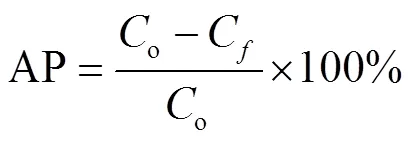
式中o为SPI溶液的初始蛋白质量浓度,mg/mL;C为滤液中的蛋白质量浓度,mg/mL。
1.3.10 数据统计分析
所有试验重复3次,结果以平均值±标准差表示。采用IBM SPSS Statistics 24软件分析ANOVA差异显著性,<0.05为差异显著。使用Image lab 5.2.1软件分析SDS-PAGE图谱,使用Origin 9.1软件分析数据并作图。
2 结果与分析
2.1 SPI基本理化分析
SPI基本成分包括蛋白、水分、脂肪、灰分等,4种不同SPI成分分析结果如表1所示。由表可知亚基缺失型SPI的蛋白含量高于东农47和其他2种亚基缺失型SPI,推测因其蛋白含量较高,其乳状液的乳化活性及乳化稳定性可能较好。但亚基缺失型SPI的水分、脂肪、灰分含量与东农47和其他2种亚基缺失型SPI略有差异。通过与范媛等[30]研究的3种SPI的比较研究以及物化特性相关性分析结果进行对比,前期制备的4种SPI基本理化指标符合常规SPI的基本要求。
2.2 SDS-PAGE分析
为了分析制备SPI的亚基组成,进一步进行了十二烷基磺酸钠聚丙烯酰胺凝胶电泳(SDS-PAGE)分析,结果如图1所示,SPI由2种主要蛋白组成,-伴大豆球蛋白(7S)和大豆球蛋白(11S)。7S由、、亚基组成,11S由酸性亚基和碱性亚基组成,4种SPI的特征条带与前人的研究结论一致,结果确定了亚基缺失型,表明SPI具有稳定遗传的生物学性状。

表1 4种SPI基本成分分析
注:表中同列相同字母表示差异不显著,不同字母表示差异显著(<0.05),下同。
Note: In the table, the same letter in the same column means no significant difference and different letters mean significant difference (<0.05), the same below.
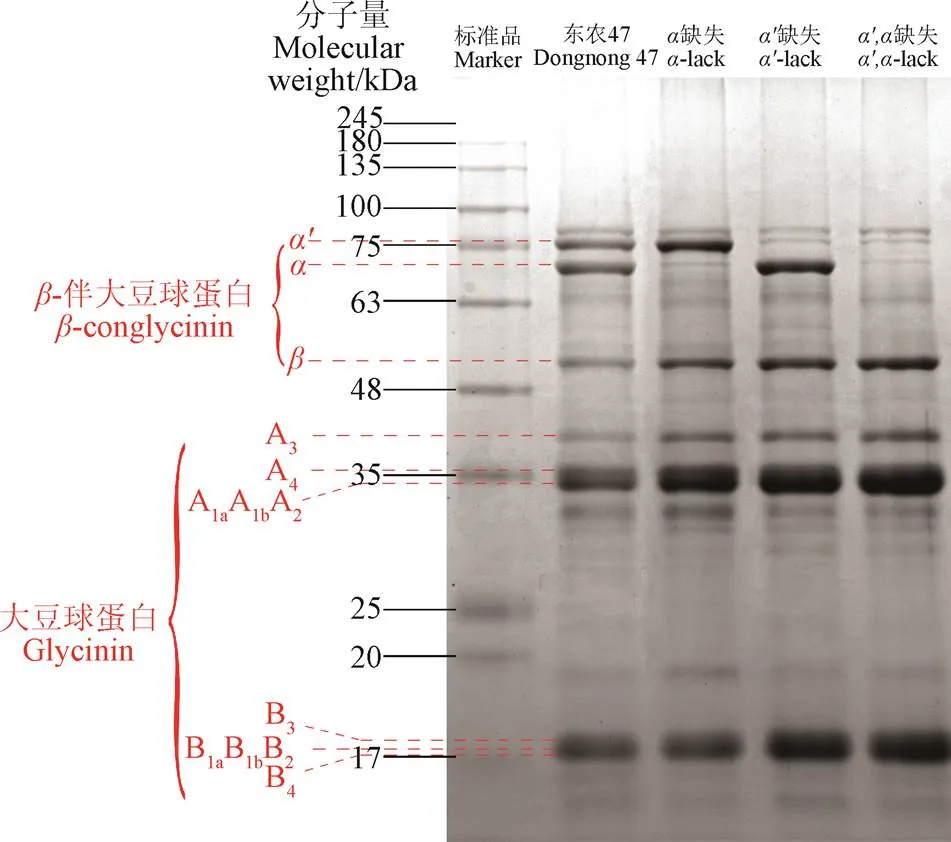
图1 4种SPI的SDS-PAGE电泳分析
2.3 不同SPI对乳状液乳化活性的影响
乳化性能是衡量蛋白质吸附在油水界面能力的指标。乳化活性指数(EAI)是评价乳状液乳化性能的重要指标[31],EAI表示蛋白单位质量稳定的界面面积。张国敏等[32]研究发现,只含+亚基类型蛋白在pH值为3.0、7.0、9.0时乳化活性高于A3+亚基缺失类型和普通大豆种子贮藏蛋白,由此可以推测亚基缺失型SPI乳状液的乳化活性可能会高于亚基缺失型SPI和普通大豆种子贮藏蛋白。4种不同亚基缺失型SPI乳状液的乳化活性指数如图2所示,结果表明:东农47提取的SPI乳状液的乳化活性指数为84.48 m2/g,亚基缺失型SPI乳状液的乳化活性指数为67.40 m2/g,亚基缺失型SPI乳状液的乳化活性指数为87.59 m2/g,、亚基缺失型SPI乳状液的乳化活性指数为56.96 m2/g,由大到小排序为亚基缺失型、东农47、亚基缺失型、和亚基缺失型。胡超等[33]研究发现,大豆蛋白的乳化活性随11S/7S比值的增加而降低,本研究得出的结论基本与之前研究一致(亚基缺失型除外),可能是因为亚基的缺失对SPI结构影响较大,从而导致其乳状液的乳化活性更好,具体原因有待进一步研究。

图2 4种SPI乳状液的乳化活性指数
2.4 不同SPI对乳状液ζ-电位的影响
-电位是表示分散体系稳定性的一项重要指标,在一定程度上可以反映乳状液液滴之间相互作用的强度。在乳状液中,包裹在油体外围的蛋白带有电荷,所以油体间存在静电排斥力,抑制了油体的聚合,因此乳状液具有一定的稳定性[34]。-电位的绝对值越大,说明液滴间斥力越大,可以有效避免液滴聚集,体系则越稳定[35]。4种不同亚基缺失型SPI乳状液的电位如图3所示,所有样品的-电位值均为负数,可能是由于SPI分子在pH值高于其等电点时存在负电荷。结果表明东农47提取的SPI乳状液的-电位绝对值为44.73 mV,亚基缺失型SPI乳状液的-电位绝对值为42.23 mV,亚基缺失型SPI乳状液的-电位绝对值为47.7 mV,、亚基缺失型SPI乳状液的-电位绝对值为39.33 mV,由大到小排序为亚基缺失型、东农47、亚基缺失型、和亚基缺失型。亚基缺失型SPI乳状液的-电位绝对值最大,说明此时颗粒间的静电斥力最大,体系中的分子不容易发生聚集[36],稳定性最好,此结果与2.3节中乳状液乳化活性结果趋势一致。

图3 4种SPI乳状液的ζ-电位
2.5 不同SPI对乳状液粒径的影响
乳状液的粒径是影响其理化性质的重要因素之一,用粒径评价乳状液稳定性,液滴的粒径越小,乳析速度则越慢,乳状液越稳定[37]。4种不同SPI乳状液的粒径如图4所示,结果表明:东农47提取的SPI乳状液的粒径为2.306m,亚基缺失型SPI乳状液的粒径为2.873m,亚基缺失型SPI乳状液的粒径为2.223m,、亚基缺失型SPI乳状液的粒径为2.891m,由小到大排序为亚基缺失型、东农47、亚基缺失型、和亚基缺失型。Sui等[15]制备的乳液粒径要大于本文的相同能量密度下的乳液的粒径,原因可能是他们使用的油的比例(体积分数约为33.3%)高于本文用油的比例(体积分数约为10%)。粒径分布(PSD)是影响乳状液物化性能和功能性能的关键参数之一,通过PSD分析进一步评价乳状液的稳定性。在高压均质过程中形成的乳状液的PSD是由粒子之间的相互作用而产生的。4种不同SPI乳状液的粒径分布图如图5所示,由于乳状液中颗粒大小相近,分布相对均匀,单峰分布乳状液的稳定性较好[15]。综上所述,亚基缺失型SPI乳状液的粒径最小,乳状液最稳定,该结果与2.3节中乳状液乳化活性和2.4节中-电位结果趋势一致。
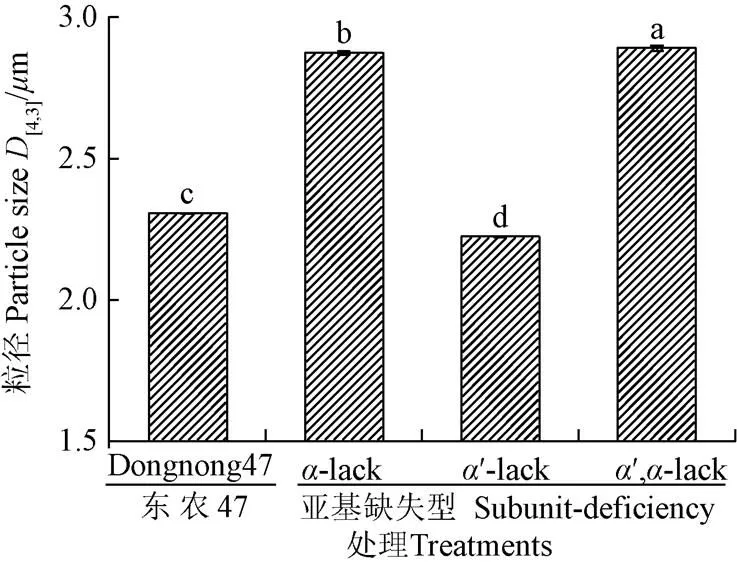
图4 4种SPI乳状液的粒径
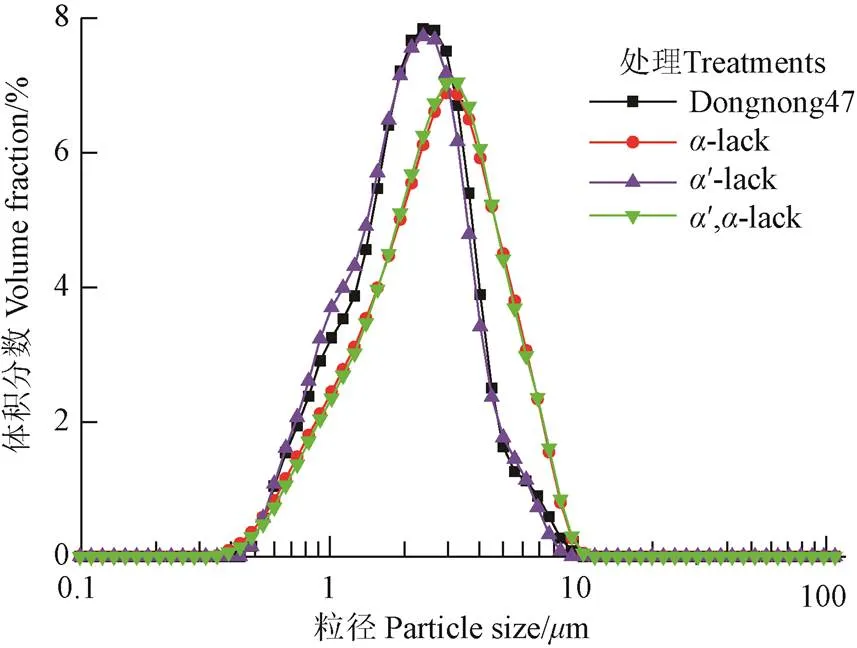
图5 4种SPI乳状液的粒径分布图
2.6 不同SPI对乳状液微观结构的影响
乳状液的微观结构也是表征乳状液稳定性的一个重要因素。不同亚基缺失型SPI乳状液的微观结构如图6所示,结果表明:亚基缺失型SPI乳状液的粒径最小,分布最均匀,而且更致密;东农47提取的SPI乳状液的粒径次之,分布较均匀[38];亚基缺失型和和亚基缺失型SPI乳状液的粒径略大,均匀程度略差一些,而且随着试验时间的增加,乳状液更容易发生聚集[39],尤其是和亚基缺失型SPI乳状液。综上所述,亚基缺失型SPI乳状液的粒径最小,液滴分布相对均匀,聚集度随时间变化更小,乳状液更稳定,此结果与2.5节中粒径及粒径分布图结果一致(图4和图5)。
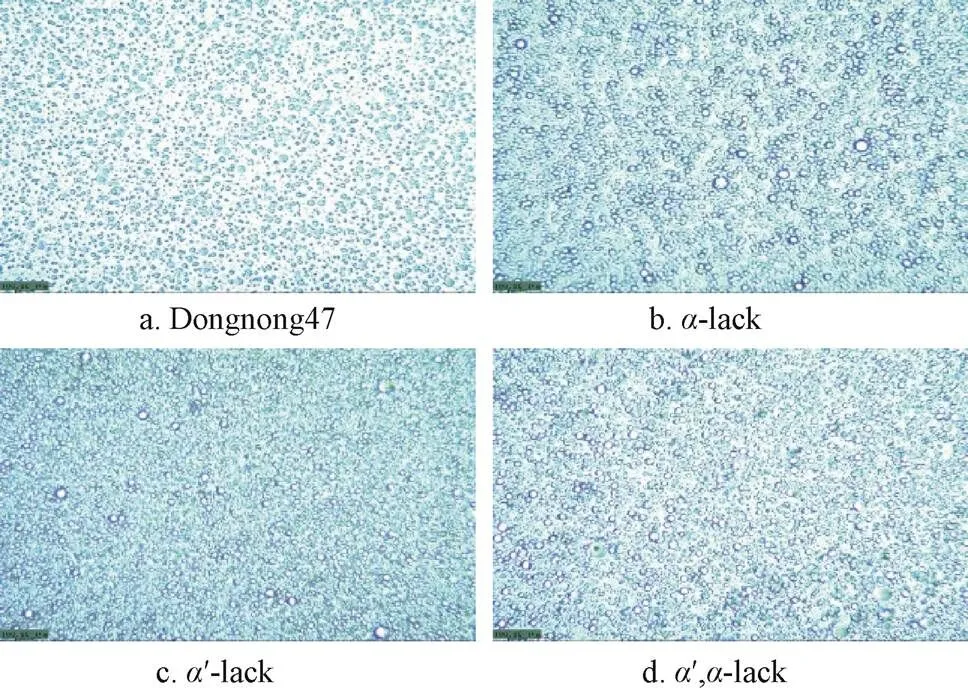
注:图中标尺为100 μm。
2.7 不同SPI对乳状液稳定动力学指数(TSI)的影响
TSI是样品在储藏期内浓度和乳液分子粒径变化幅度的综合反映,变化幅度越大,TSI越大,乳状液越不稳定[40],即TSI稳定系数越小,斜率越小,乳状液越稳定[41]。4种不同SPI乳状液的稳定动力学指数如图7所示,从变化趋势来看,4种不同SPI乳状液的TSI稳定系数均逐步趋于稳定,结果表明:稳定性由大到小为亚基缺失型、东农47、亚基缺失型、和亚基缺失型,亚基缺失型SPI乳状液的TSI稳定系数最小,斜率最小,乳状液最稳定。此结果与乳状液的其他性质得到的结果趋势一致。张国敏等[32]研究表明,当pH值为3.0、7.0、9.0时,只含7S亚基类型与只含+亚基类型乳化稳定性高于A3+亚基缺失体和普通大豆种子贮藏蛋白,由此也可以推测亚基缺失型SPI乳状液的乳化稳定性可能会高于亚基缺失型SPI和普通大豆种子贮藏蛋白。
2.8 不同SPI对乳状液界面蛋白吸附量的影响
蛋白分子吸附在油滴表面形成蛋白膜,提供空间稳定作用,防止乳状液絮凝或者凝结现象的发生,影响乳状液稳定性[42]。4种不同SPI乳状液的界面蛋白吸附量(AP)如图8所示,结果表明:东农47提取的SPI乳状液的AP为29.66%,基缺失型SPI乳状液的AP为28.14%,亚基缺失型SPI乳状液的AP为31.40%,、亚基缺失型SPI乳状液的AP为26.11%,界面蛋白吸附量由大到小为亚基缺失型、东农47、亚基缺失型、和亚基缺失型。亚基缺失型SPI乳状液的AP最大,乳状液最稳定,结合乳状液的其他性质,可以相互印证。
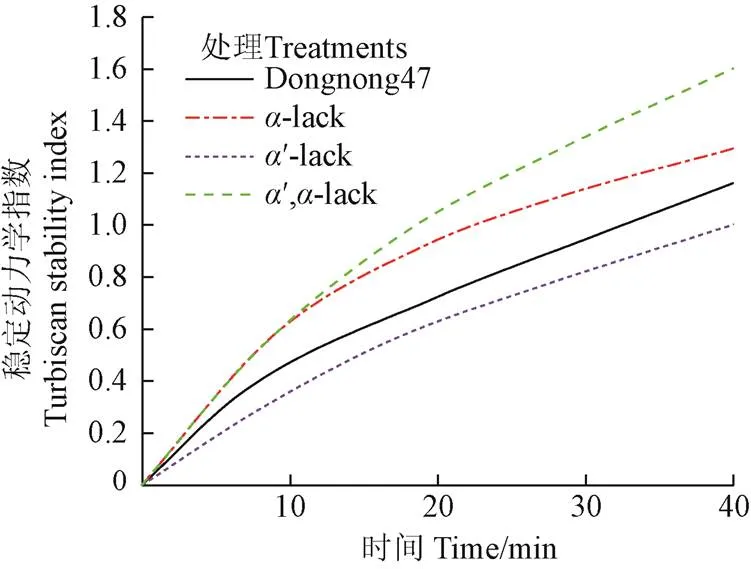
图7 4种SPI乳状液的稳定动力学指数

图8 4种SPI乳状液的界面蛋白吸附量
3 结 论
以东农47和3种不同亚基缺失型(缺失、缺失以及缺失)大豆为原料提取大豆分离蛋白(Soy Protein Isolate,SPI),利用高压均质技术制备乳状液,研究、亚基对大豆分离蛋白乳化特性的影响,得出以下结论:
1)4种不同SPI乳状液乳化活性和乳化稳定性结果排序由大到小均为亚基缺失型、东农47、亚基缺失型、和亚基缺失型,即亚基缺失型SPI制备的乳状液乳化活性和乳化稳定性均最好。
2)亚基缺失型大豆乳化特性的研究为中国高乳化性大豆蛋白系列产品的开发应用提供了理论支撑和技术支持。亚基缺失型大豆具有进一步精深加工的潜力,并且在减少下游加工成本的同时符合国家大豆产业技术体系“专一产品,专用品种”的行业趋势。
[1]Tang C H. Emulsifying properties of soy proteins: A critical review with emphasis on the role of conformational flexibility[J]. Critical Reviews in Food Science and Nutrition, 2015, 57(12): 2636-2679.
[2]Fernández-Ávila C, Escriu R, Trujillo A J. Ultra-high pressure homogenization enhances physicochemical properties of soy protein isolate-stabilized emulsions[J]. Food Research International, 2015, 75: 357-366.
[3]Tadros, Tharwat F. Emulsion Formation and Stability (Tadros/Emulsion Formation and Stability) Emulsion Formation, Stability, and Rheology[M]. Wiley‐VCH Verlag GmbH & Co. KGaA, 2013: 1-75.
[4]Jambrak A R, Lelas V, Mason T J, et al. Physical properties of ultrasound treated soy proteins[J]. Journal of Food Engineering, 2009, 93(4): 386-393.
[5]Fukushima D. Recent progress in research and technology on soybeans[J]. Food Science and Technology Research, 2001, 7(1): 8-16.
[6]陈海敏,华欲飞. 大豆蛋白组成与功能关系研究[J]. 西部粮油科技,2001,26(3):36-38.
Chen Haimin, Hua Yufei. Structure-function relationships of soy protein[J]. Western Grain and Oil Science and Technology, 2001, 26(3): 36-38. (in Chinese with English abstract)
[7]刘頔,赵晓燕,符力丹. 大豆蛋白中7S与11S球蛋白的研究进展[J]. 食品研究与开发,2016,37(17):201-204.
Liu Di, Zhao Xiaoyan, Fu Lidan. Study of 7S and 11S globulins from soy protein[J]. Food Research And Development, 2016, 37(17): 201-204. (in Chinese with English abstract)
[8]Hu H, Cheung I W Y, Pan S, et al. Effect of high intensity ultrasound on physicochemical and functional properties of aggregated soybean-conglycinin and glycinin[J]. Food Hydrocolloids, 2015, 45: 102-110.
[9]刘春,王显生,麻浩. 大豆种子贮藏蛋白亚基特异种质的蛋白功能性评价[J].中国油脂,2008,33(8):35-40.
Liu Chun, Wang Xiansheng, Ma Hao. Evaluations on functional properties of soybean protein isolates prepared from cultivars with seeds to rage protein subunits variation[J]. China Oils and Fats, 2008, 33(8): 35-40. (in Chinese with English abstract)
[10]Cheng Cuilin, Shi Yanguo, Wang Zhenyu, et al. Effect of protein subunits and 7S/11S on functional properties of SPI[J]. Food Science, 2006, 27(3): 70-74.
程翠林,石彦国,王振宇,等. 大豆蛋白亚基组成对其功能特性的影响[J]. 食品科学,2006,27(3):70-74. (in English with Chinese abstract)
[11]刘珊珊,滕卫丽,姜自芹,等. 大豆7S球蛋白-亚基缺失型种质创新[J]. 作物学报,2010,36(8):1409-1413.
Liu Shanshan, Teng Weili, Jiang Ziqin, et al. Development of soybean germplasm lacking of 7S globulin-subunit[J]. Acta Agronomica Sinica, 2010, 36(8): 1409-1413. (in Chinese with English abstract)
[12]宋波,蓝岚,田福东,等. 大豆7S球蛋白亚基缺失及(+)亚基双缺失品系的回交转育[J]. 作物学报,2012,38(12):2297-2305.
Song Bo, Lan Lan, Tian Fudong, et al. Development of soybean lines with-subunit or (+)-subunits deficiency in 7S gobulin by backcrossing[J]. Acta Ageonomica Sinica, 2012, 38(12): 2297-2305. (in Chinese with English abstract)
[13]拓云,霍彩琴,田福东,等. SSR标记辅助回交转育大豆7S球蛋白-亚基致敏蛋白缺失新品系[J]. 中国油料作物学报,2014,36(1):1-9.
Tuo Yun, Huo Caiqin, Tian Fudong, et al. Soybean 7S (-conglycinin)-subunit deficiency lines developed by backcrossing assisted by SSR marker background selection[J]. Chinese Journal of Oil Crop Sciences, 2014, 36(1): 1-9. (in Chinese with English abstract)
[14]韩艳婧. 7S-亚基缺失型低致敏大豆新材料的选育、评价与应用[D]. 哈尔滨:东北农业大学,2017.
Han Yanjing. Breeding, Evaluation and Application of Low Allergic Soybean New Materials for 7S-subunit Deletion[D]. Harbin: Northeast Agricultural University, 2017. (in Chinese with English abstract)
[15]Sui Xiaonan. Impact of ultrasonic treatment on an emulsion system stabilized with soybean protein isolate and lecithin: Its emulsifying property and emulsion stability[J]. Food Hydrocolloids, 2016, 63: 727-734.
[16]田少君,夏克东,刘斯博,等. 不同干燥方法对星油藤分离蛋白结构和功能性质的影响[J]. 中国粮油学报,2017,32(2):57-61.
Tian Shaojun, Xia Kedong, Liu Sibo, et al. Effect of different desiccant methods on the structure and functional properties of sacha inchi proteins[J]. Journal of the Chinese Cereals and Oils Association, 2017, 32(2): 57-61. (in Chinese with English abstract)
[17]Zhou Yanping, Li Xingfei, Hua Yufei, et al. The absence of lipoxygenase and 7S globulin of soybeans and heating temperatures on the properties of soymilks and soy yogurts[J]. LWT-Food Science and Technology, 2019, 115. [2019-06-24] https://doi.org/10.1016/j.lwt.2019.108431.
[18]GB/T 5009.5-2016,食品中蛋白质的测定[S]. 北京:中国标准出版社,2016.
[19]GB/T 5009.3-2016,食品中水分的测定[S]. 北京:中国标准出版社,2016.
[20]GB/T 5009.4-2016,食品中灰分的测定[S]. 北京:中国标准出版社,2016.
[21]GB/T 5009.6-2016,食品中脂肪的测定[S]. 北京:中国标准出版社,2016.
[22]王喜波,张安琪,王玉莹,等. 巴氏杀菌和超巴氏杀菌对牛乳清蛋白结构及热稳定性的影响[J]. 农业工程学报,2019,35(6):307-313.
Wang Xibo, Zhang Anqi, Wang Yuying, et al. Effect of pasteurization and ultra-pasteurization on structure and thermal stability of fresh milk whey protein[J]. Transactions of the Chinese Society of Agricultural Engineering (Transactions of the CSAE), 2019, 35(6): 307-313. (in Chinese with English abstract)
[23]彭棋,阮记明,黄冬艳,等. 大豆球蛋白提取条件优化及7S和11S亚基的鉴定[J]. 江西农业大学学报,2014(5):1139-1144.
Peng Qi, Ruan Jiming, Huang Dongyan, et al. Optimization of the conditions for soybean glycinin extraction and analysis of 7S and 11S in soybean protein[J]. Acta Agriculturae Universitatis Jiangxiensis, 2014(5): 1139-1144. (in Chinese with English abstract)
[24]Taha A, Hu Tan, Zhang Zhuo, et al. Effect of different oils and ultrasound emulsification conditions on the physicochemical properties of emulsions stabilized by soy protein isolate[J]. Ultrasonics Sonochemistry, 2018, 49: 283-293.
[25]Wang Shengnan, Yang Jinjie, Shao Guoqiang, et al. Dilatational rheological and nuclear magnetic resonance characterization of oil-water interface: Impact of pH on interaction of soy protein isolated and soy hull polysaccharides[J]. Food Hydrocolloids, 2019, 99: 105366.
[26]Leong T S H, Wooster T J, Kentish S E, et al. Minimising oil droplet size using ultrasonic emulsification[J]. Ultrasonics Sonochemistry, 2009, 16(6): 721-727.
[27]王胜男,杨晋杰,邵国强,等. 大豆可溶性多糖与Fe2+对O/W乳状液物理稳定性及流变特性的影响[J]. 食品工业科技,2019,40(2):81-86.
Wang Shengnan, Yang Jinjie, Shao Guoqiang, et al. Effect of soybean soluble polysaccharides and Fe2+on physical stabilityand rheological properties of O/W emulsion[J]. Science and Technology of food industry, 2019, 40(2): 81-86. (in Chinese with English abstract)
[28]Chen Lin, Chen Jianshe, Ren Jiaoyan, et al. Effects of ultrasound pretreatment on the enzymatic hydrolysis of soy protein isolates and on the emulsifying properties of hydrolysates[J]. Journal of Agricultural and Food Chemistry, 2011, 59(6): 2600-2609.
[29]Lowry O H, Rosebrough N J, Farr A L, et al. Protein measurement with the Folin phenol reagent[J]. Journal of Biological Chemistry, 1951, 193(1): 265-275.
[30]范媛,马永强,袁美玲,等. 三种大豆分离蛋白的比较研究和物化特性相关性分析[J]. 大豆科技,2012,33(4):33-38.
Fan Yuan, Ma Yongqiang, Yuan Meiling, et al. Comparison of three kinds of soybean protein isolate and correlation of physiochemical properties[J]. Soybean Science & Technology, 2012, 33(4): 33-38. (in Chinese with English abstract)
[31]Jamdar S N, Rajalakshmi V, Pednekar M D, et al. Influence of degree of hydrolysis on functional properties, antioxidant activity and ACE inhibitory activity of peanut protein hydrolysate[J]. Food Chemistry, 2010, 121(1): 178-184.
[32]张国敏. 种子贮藏蛋白亚基缺失大豆种质的鉴定及其蛋白质功能性评价与′亚基缺失的分子机制[D]. 南京:南京农业大学,2014.
Zhang Guomin. Identification of Soybean Lines Lacking Different Seed Storage Protein Submits, Their Functional Properties of Proteins and the Molecular Mechanism of Lacking′ Subunit[D]. Nanjing: Nanjing Agricultural University, 2014. (in Chinese with English abstract)
[33]胡超,黄丽华,李文哲. 大豆球蛋白11S/7S比值对大豆蛋白功能性的影响[J]. 中国粮油学报,2004,19(1):40-42.
Hu Chao, Huang Lihua, Li Wenzhe. Effects of 11S/7S ratios of soybean globulin protein on functionalities of soybean protein[J]. Journal of the Chinese Cereals and Oils Association, 2004, 19(1): 40-42. (in Chinese with English abstract)
[34]吴海波,江连洲. CaCl2和pH值对水酶法提取大豆油形成乳状液破乳效果影响[J]. 农业工程学报,2018,34(23):299-306.
Wu Haibo, Jiang Lianzhou. Effect of CaCl2and pH value on demulsification of emulsion from enzyme-assisted aqueous extraction processing of soybean oil[J]. Transactions of the Chinese Society of Agricultural Engineering (Transactions of the CSAE), 2018, 34(23): 299-306. (in Chinese with English abstract)
[35]Limage S, Schmitt M, Vincent-Bonnieu S, et al. Characterization of solid-stabilized water/oil emulsions by scanning electron microscopy[J]. Colloids and Surfaces A: Physicochemical and Engineering Aspects, 2010, 365(1/2/3): 154-161.
[36]Wong B T, Day L, Augustin M A. Deamidated wheat protein-dextran Maillard conjugates: Effect of size and location of polysaccharide conjugated on steric stabilization of emulsions at acidic pH[J]. Food Hydrocolloids, 2011, 25(6): 1424-1432.
[37]王喜波,崔强,张安琪,等. 超声处理改善不同比例大豆-乳清混合蛋白理化性质[J]. 农业工程学报,2018,34(22):299-305.
Wang Xibo, Cui Qiang, Zhang Anqi, et al. Ultrasonic treatment improving physical and chemical properties of soybean-whey mixed protein in different proportions[J]. Transactions of the Chinese Society of Agricultural Engineering (Transactions of the CSAE), 2018, 34(22): 299-305. (in Chinese with English abstract)
[38]李杨,孙红波,董济萱,等. 花青素与大豆分离蛋白非共价/共价作用对其界面功能性质的影响[J]. 食品科学,2018,39(6):32-38.
Li Yang, Sun Hongbo, Dong Jixuan, et al. Effects of non-covalent/covalent interactions between anthocyanins and soybean protein isolates on interface function[J]. Food Science, 2018, 39(6): 32-38. (in Chinese with English abstract)
[39]王珺. 白藜芦醇W/O/W运载体系的构建及其吸收转运机制研究[D]. 北京:中国农业科学院,2018.
Wang Jun. Formulation of Resveratrol W/O/W Delivery System and the Mechanism of its Absorption and Transport[D]. Beijing: Chinese Academy of Agricultural Sciences Dissertation, 2018. (in Chinese with English abstract)
[40]白洁,彭义交,李玉美,等. 基于Turbiscan稳定性分析仪技术研究微细化处理在燕麦豆乳中的应用[J]. 食品工业科技,2015,36(13):108-112.
Bai Jie, Peng Yijiao, Li Yumei, et al, Application of micronized treatment in oat-soybean beverage using turbiscan technology[J]. Science and Technology of Food Industry, 2015, 36(13): 108-112. (in Chinese with English abstract)
[41]Xu Duoxia, Zhang Jinjing, Cao Yanping, et al. Influence of microcrystalline cellulose on the microrheological property and freeze-thaw stability of soybean protein hydrolysate stabilized curcumin emulsion[J]. LWT - Food Science and Technology, 2016, 66: 590-597.
[42]Dickinson E. Biopolymer-based particles as stabilizing agents for emulsions and foams[J]. Food Hydrocolloids, 2016, 68: 219-231.
Effects of the subunit-deficiency ofand′ on emulsifying properties of soy protein isolate
Sun He1,3, Yu Hansong1,3※, Fan Hongliang1,3, Fu Hongling1,3, Shan Dandan1,3, Lyu Bo4, Song Bo2, Liu Shanshan2
(1.130118,; 2.150030,; 3.130118,; 4.150030
Soybean protein is one of the major plant-derived protein resources due to its high yield and a wide range of processing applications. It is necessary to effectively improve processing properties of soybean protein, and thereby significantly enhance its nutritional value and economic potency. Most previous research mainly focused on the effects of external physical or chemical conditions and other complex system on the processing parameters of soybean protein. Few studies developed to explore the effect of various subunits compositions on the processing properties of soybean protein, particularly lacking on the deficiency of small subunit. Therefore, this study aims to investigate the effects ofandsubunits in-conglycinin on emulsifying properties of soybean protein.In the experiment, some raw materials includeDongnong 47 and three different protein subunit-deficiency (subunit-deficiency,subunit-deficiency and,subunit-deficiency) soybeans, to extract thesoy protein isolates(SPI), by using the method of alkali solution acid precipitation for the preparation of emulsion. The subunit composition was then analyzed by sodium dodecyl sulfonate polyacrylamide gel electrophoresis (SDS-PAGE). Some parameters, including emulsifying activity index (EAI),-potential, particle size, microstructure, turbiscan stability index (TSI), and interface adsorbed protein, were selected to evaluate the effect ofandsubunits in-conglycinin (7S) on emulsifying properties of soy protein isolate. The results showed that the soy protein isolate emulsion ofsubunit-deficiency has thehighest emulsifying activity index (87.59 m2/g), the maximum-potential absolute (47.7 mV), the minimum particle size (2.223m), the smallest molecules and most evenly distributed through the analysis of microstructure, the smallest turbiscan stability index (TSI), and the maximum content of interface adsorbed protein (31.40%), compared with other two SPI.The emulsion stability of soy protein isolate ranked in order:subunit-deficiency, Dongnong 47,subunit-deficiency,andsubunit-deficiency. Safe and risk-free high-emulsifying products become an urgent demand because nutritious and healthy food has received increasing attention with the gradual improvement of people's living standard and the country's attention to the big health industry in recent years.Soy protein isolate, as a sort of amphiphilic structure, is commonly used in industrial production due to its high nutritional value and many functional characteristics.Therefore, emulsions can be served as cosmetic and pharmaceutical applications, as well in several food products, such as ice cream and mayonnaisewith its different types. Since emulsions are an unstable system forming by water, oil, and emulsifiers, the instability of emulsion layer may reduce the shelf life of emulsion products. It was found that the addition of SPI with emulsifying properties can stabilize the emulsion in this study. The studies demonstrated that thesubunit-deficiency SPI obtained through breeding with Chinese genetic background can pose a great positive impact on the emulsifying properties of soybean protein, and thereby to effectively improve the quality characteristics of soybean protein isolate series products. This finding can also provide a theoretical and technical support for the development and application of high-emulsifying soybean protein series products. This study can offer a promising potential for intensive processing and cost-saving downstream processing, and thereby to meet the industry demands of “specific products, special varieties” in the national soybean industrial technology R&D system.
emulsifying activity; emulsion stability; microstructure; soy protein isolate; subunit-deficiency
孙贺,于寒松,范宏亮,等.和′亚基缺失对大豆分离蛋白乳化特性的影响[J]. 农业工程学报,2020,36(10):261-268.doi:10.11975/j.issn.1002-6819.2020.10.032 http://www.tcsae.org
Sun He, Yu Hansong, Fan Hongliang, et al. Effects of the subunit-deficiency ofand′ on emulsifying properties of soy protein isolate[J]. Transactions of the Chinese Society of Agricultural Engineering (Transactions of the CSAE), 2020, 36(10): 261-268. (in Chinese with English abstract) doi:10.11975/j.issn.1002-6819.2020.10.032 http://www.tcsae.org
2020-02-24
2020-05-01
国家大豆产业技术体系(CARS-04)
孙贺,主要从事大豆分离蛋白乳化及界面特性研究。Email:sunhe920417@163.com
于寒松,博士,教授,博士生导师,主要从事大豆精深加工及综合利用研究。Email:yuhansong@163.com
10.11975/j.issn.1002-6819.2020.10.032
TS214.2
A
1002-6819(2020)-10-0261-08

